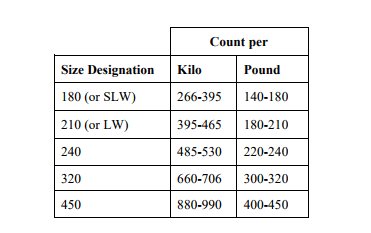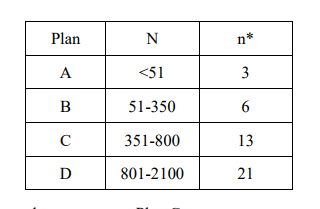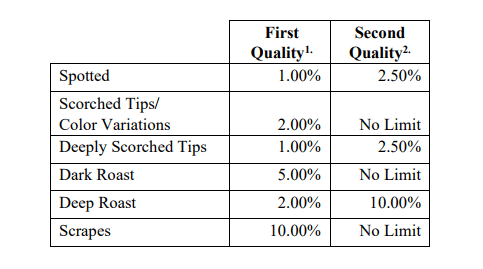Association of Food Industries Cashew Specification Guidelines
The Association of Food Industries (AFI) has established quality and technical specifications for cashew kernels to promote uniformity and ensure safety across the cashew trade. These AFI guidelines provide processors, importers, and buyers with definitive standards regarding proper storage, packaging, labeling, food safety parameters, defects, grading criteria, and corrective measures for non-conformances. With a focus on elements like moisture content, infestation prevention, pathogen limits, precise sizing, and flavor, the AFI cashew specifications allow industry stakeholders to align on consistent quality metrics. This facilitates commerce in cashew kernels while protecting consumers. Key aspects of the AFI criteria are summarized below.
General Requirements
B. The cashews shall be packed in new, clean, dry, leakproof, lead-free containers with an airtight (hermetic) seal and without internal paper liners. Packaging shall be of sufficient strength to assure the integrity of the product during normal shipment and storage. The outer container shall be free of infestation and visible mold and sealed without staples, unless specified by the end user. Cardboard cartons must be a minimum of 200-pound test, 32 ECT. Only food-grade CO2 is permitted, at a minimum mix of 60% CO2; the balance will be nitrogen.
C. Only pesticides approved for use on cashews may be used and residues must be within the tolerances set by the government of the importing country. No detectable residue is permitted for any pesticide that is not approved for use on cashews in the importing country. Use of/existence of methyl bromide, Naphthalene and any other chemicals that create a food safety risk and/or tainted taste are prohibited. Only chemicals approved in the receiving country may be used.
D. All cartons must meet the importing country’s labeling requirements and shall be clearly marked with the following:
1. Name of the product and trade name or brand name, if any.
2. Name and address of producer or packer.
3. Grade.
4. Gross/net weight.
5. Country of origin.
6. Product, i.e. cashews.
7. Allergen marking.
8. Lot numbers/production/date codes.
9. Other marks agreed to by buyer and seller.
Shipper’s packing list must detail lot/production/date codes and corresponding quantities for traceability and to ensure representative sampling.
E. All shipments shall be inspected prior to loading.
F. The moisture level of the cashews shall be 3%-5%, as determined by a Loss on Drying Method using a moisture balance at 105°C, AACCI Method 44-15 (modified) or an equivalent loss on drying method that correlates with AOAC Official Method 925.40 Moisture in Nuts and Nut Products or equivalent vacuum oven method.
G. If a roast test is required in a contract, it should be conducted in accordance with Appendix II.
H. Strong blocking is not permitted. Strong blocking is defined as blocking which cannot be freed other than with the use of external tools.
I. Cashew kernels shall be free of hard or sharp foreign objects and hair.
Technical Requirements
Tests for Free Fatty Acids (FFA) and Peroxide Value (PV):
• Samples must be prepared by solvent extraction, Soxhlet or equivalent (Must not be cold-pressed.)
• FFA: Max. 1.5% as Oleic Acid. Test Method AOCS Ca 5a-40 or equivalent official method.
• PV: Max 5 meq/kg, Test Method AOCS Cd 8b-90 or equivalent official method.
A. Aflatoxin: Aflatoxin levels must meet the tolerance set forth by the country in which the goods are sold.
B. E. coli: Non-Detectable
C. Salmonella: Negative per 375g
D. Listeria monocytogenes: Negative per 125g
E. Staphylococcus aureus: Less than 10 CFU/g
F. Storage Life: Empirical knowledge within the industry suggests it’s reasonable to expect a 24-month storage life when
cashews are stored under proper conditions. Per the Postharvest Center at the University of California: The optimal storage
temperature for tree nuts is 0‐10C (32-50° F) with relative humidity at 55‐70%.
G. Foreign Material: Hair, glass, metal, stones and other hard or sharp foreign objects are prohibited.
H. Harmless Extraneous Matter <0.01%
Sizing
Size Tolerance: Whole kernels of a lower size grade shall not exceed 10% by weight.
The quantity of broken kernels or pieces in whole kernels shall not exceed 10% by weight.
The quantity of pieces present in butts and splits shall not exceed 10% by weight.
The quantity of the next lower size grade in pieces shall not exceed 5% by weight.

Whole (W)
A cashew kernel is classified as whole if it has the characteristic shape of a cashew kernel and not more than 1/8th of the kernel has
been broken off. This grade may also be designated as W.
Butts (B)
Kernels which have been broken crosswise, are less than 7/8 but not less than 3/8 of a whole kernel and the cotyledons are still
naturally attached. This grade may also be designated as B.
Splits (S)
One half of a cashew kernel that has been split lengthwise, provided not more than 1/8 of this cotyledon has been broken off. This
grade may also be designated as S.
Definitions
SERIOUS DAMAGE includes but is not limited to insect, rodent or bird filth; visible mold, rancid flavor, decay; imbedded or adhering
dirt, solder, shell or mesocarp.
ADHERING MATTER – cashew meal or extraneous matter on the surface of the kernel causing permanent discoloration.
INSECT DAMAGE – is visible damage to the kernel from live or dead insects, mites in any stage of development, insect excreta or
fragments – frass – webbing – boring – powdery residue – cast larval casings and/or the evidence of insects or insect activity in the
packaging.
RODENT DAMAGE – evidence of rodent activity.
BIRD DAMAGE – pieces of feather, bird excreta.
VISIBLE MOLD – mold detectable with the naked eye.
RANCIDITY – is a breakdown of the oils in the kernel giving it an off-flavor or aroma.
OFF FLAVOR-AROMA – An off flavor-aroma is any atypical flavor or aroma, including those caused by rancidity, lipid decomposition,
fermentation, microbial activity, infestation or chemical taint.
SUTURE – The line of closure between the valves of a cashew kernel.
HARMLESS EXTRANEOUS MATTER – includes but is not limited to soft vegetable matter, industrial fibers, paper and threads, that do not
present any inherent hazards to health.
DEFECTS include superficial and intrinsic damage which adversely affects the appearance of the lot such as scorching,
blemishes, discoloration, immature or shriveled kernels, and kernels with pitted black or brown spots, adhering testa, scrapes, flux
marks and speckles. Defects vary by grade. The presence of kernels of a lower grade is scored as a defect.
Examples of defects include:
SCORCHING – a discoloration due to overheating during shelling or blanching.
BLEMISHES OR DISCOLORATION – speckles or spots in aggregate >3 mm on the kernels from causes other than shelling or blanching;
discolored curved lines, loops, or swirls on the kernel that are apparent after removal of testa.
IMMATURE – kernels are underdeveloped and do not have the characteristic shape of a cashew kernel.
SLIGHTLY SHRIVELED – a slight withering of the outer surface of the kernel.
SCRAPED – damage to the outer surface of the kernel by knife scratches affecting an aggregate area >5mm. Scrapes on the inside of
the natural curve of the kernel are not counted as scrapes.
SHRIVELED – a complete withering of the kernel that distorts its characteristic shape.
PITTED SPOTS – black, brown, or other colored spots in aggregate in excess of 1 mm caused by pre-harvest attack on the kernel.
ADHERING TESTA – Testa is the natural integument of the cashew seed. Kernels are scored as affected by adhering testa when a
surface area greater than 2mm in aggregate is affected; provided, that not more than 1/16 of the surface of a whole or equivalent, or
1/8 of a split or butt, in aggregate, are damaged by adhering testa; in which case, the affected kernels shall be
scored as “seriously damaged” by adhering testa.”
SUPERFICIAL DAMAGE – deep knife cuts on the surface of the kernel that change the characteristic shape of the nut.
FLUX MARKS – black or brown marks on the surface of the kernels caused by flux dripping onto them when a tin container is sealed.
SPOTTING AFTER ROASTING – Brown spots on the surface of the kernel that are not apparent when the kernels are raw but when the
kernels are roasted.
SCRAPES AFTER ROASTING – Damage to the surface of the kernel when testa and other defects are removed by the use of a knife. The
scraped areas are lighter after roasting and give an uneven appearance to the roast.
BLOCKING – Bonding of cashew kernels in the presence of high moisture and high vacuum pressure.
Sampling Plan for Cashews
Where,
N is the lot size for 50 lbs. net cartons
n is the number of cartons sampled (subsamples).

For supersacks or totes, use Plan C.
*The Sampling Plan for a tightened inspection is 2n (double sampling). Tightened inspection is optional for reinspection or lots with a
history of failure.
Collect approximately 275-500g for each subsample, provided that the total sample is not less than 3,500g. Samples should be
collected randomly from the lot, and without prejudice from 3 or more sites in each package.
AFI ANALYTICAL METHOD FOR INSECT INFESTATION AND SERIOUS DAMAGE
Option II – Examination by subsample: Examine a minimum of 100 whole kernels or 100g of broken grade kernels per subsample. When a kernel is damaged by multiple defects, only the most serious lower-grade defect is scored. Never count the same kernel more than once for serious damage.
AFI ANALYTICAL METHOD FOR GRADE
Assuming that the samples collected from the lot are reasonably similar in appearance, a well-mixed composite sample (raw or roast)
may be examined for grade. Determine breakage in a 1,000g composite sample and defects in a 500g composite sample. Calculate
percentages by weight. Only the most serious lower grade defect is scored when a kernel is damaged by multiple defects. Never score
the same kernel more than once.
Determine percentage of smaller and larger grade whole cashews in a 500g composite sample. Calculate percentages
by weight. Determine the count in a one-pound (454g) composite sample of whole kernels.
Determine the size range of pieces with specified and calibrated wire-mesh sieves with square openings. Sieve a 200g composite
sample for 2 minutes using a mechanical sieve shaker. Calculate percentages by weight.
Determine defects after roasting a 500g composite sample. Calculate percentages by weight.
Off-flavor aroma and confirmation of rancidity is determined by a sensory panel. An off-flavor aroma is any atypical flavor-aroma
including those caused by rancidity, decomposition, fermentation, microbial activity, infestation or chemical taint.
Color analysis of samples must be done under full spectrum lighting.
Test for Roasted Kernels
Almost all cashew kernels are sold to the consumer in the US after roasting. The appearance of the roasted kernel is critical for
consumer acceptance. An uneven roast is never appealing to the consumer.
It is therefore recommended that shippers roast cashew samples prior to packing to determine the appearance that a lot will have after
roasting. This is simply good manufacturing practices.
The roast test also confirms the proper classification of a lot, as to whether it should be sold as first, second, or third quality.
Roasting Procedure: The kernels should be roasted (fried) in a clear vegetable oil, e.g. peanut oil, which should be replaced as soon as
it starts to deteriorate (when free fatty acids exceed 1%). The oil is brought to a temperature of approximately 300 – 310F (149C) and
is kept on the heat source while cashews are immersed in the hot oil for a period of 2-3 minutes. Any lowering of the temperature of
the oil by the immersion of the cashews will not require any lengthening of the roasting period. The kernels must be stirred several
times during roasting. Adjustments in time and temperature are recommended when roasting butts, splits, and small kernels.
Defects:
Spotting after Roast – brown spots that appear on the surface of the kernel after roasting, but which are not visible in the raw.
Scorched tip – a tip that is significantly darker than the remainder of the kernel due to a scorching during shelling or blanching.
Color Variation – any discoloration, other than a scorch mark, which detracts from the uniform appearance of the kernel.
Dark roast – a light to medium brown color in some kernels that detracts from the uniform appearance of kernels that are significantly
lighter.
Deep roast – a deep brown color in some kernels that detracts from the uniform appearance of kernels that are significantly lighter.
Scrapes – superficial damage and knife scratches greater than 5mm in diameter that show up as light spots on the surface of the
roasted kernel.
Uneven roast – a roast with more than 7% total of the following defects: spotted, scorched tips/color variations, deeply scorched tips,
dark roast, and deep roast. A roast is also uneven if more than 10% of the kernels show scrapes after roasting or the combination of
roast defects and scraped kernels is greater than 15%. A roast might also appear uneven due to mixed raw cashew nuts or processing,
resulting in light and dark roasting kernels.
Maximum Tolerances for Defects in First and Second Quality Roasted Cashew Kernels

1.The Total Defect Level for First Quality cannot exceed 7% for defects other than scrapes.
2.On Second Quality there are only limits for spotted, deeply scorched tips and deep roast. No total defect level is necessary for second
quality.
CONTACT FORM
We understand selecting the ideal cashew processing machinery is a crucial decision for your business. Filling our simple contact form will help us grasp your requirements accurately and suggest customized solutions for long-term efficiency gains. Our team will get in touch shortly to initiate the best pricing and features discussion for your upgrade needs.

